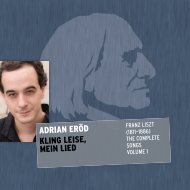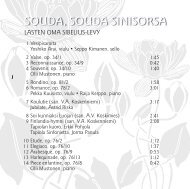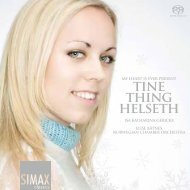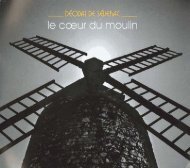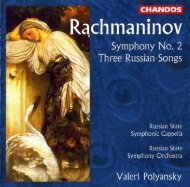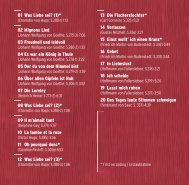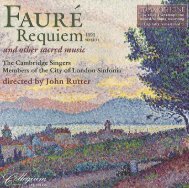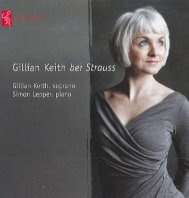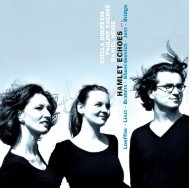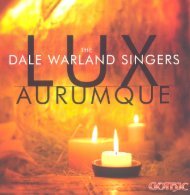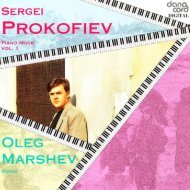572114bk Schubert EU
572114bk Schubert EU
572114bk Schubert EU
Create successful ePaper yourself
Turn your PDF publications into a flip-book with our unique Google optimized e-Paper software.
SCHUBERT<br />
Mass No. 5 • Magnificat<br />
Immortal Bach Ensemble<br />
Leipziger Kammerorchester<br />
Morten Schuldt-Jensen
Franz <strong>Schubert</strong> (1797–1828)<br />
Mass No. 5 in A flat major • Magnificat in C major<br />
Mass No. 5 in A flat major, D. 678 40:01<br />
Kyrie<br />
1 Kyrie eleison 5:47<br />
Gloria<br />
2 Gloria in excelsis Deo 2:20<br />
3 Gratias agimus tibi 3:29<br />
4 Domine Deus, Agnus Dei 2:27<br />
5 Cum Sancto Spiritu 4:00<br />
Credo<br />
6 Credo in unum Deum 2:19<br />
7 Et incarnatus est 3:50<br />
8 Et resurrexit 1:54<br />
9 Confiteor 1:40<br />
Sanctus<br />
0 Sanctus, sanctus, sanctus 2:12<br />
! Osanna in excelsis 0:37<br />
Benedictus<br />
@ Benedictus qui venit 3:49<br />
Agnus Dei<br />
# Agnus Dei, qui tollis peccata mundi 3:16<br />
$ Dona nobis pacem 2:19<br />
Magnificat in C major, D. 486 8:50<br />
% Magnificat anima mea Dominum 2:04 & Gloria Patri 3:43<br />
^ Deposuit potentes de sede 3:03<br />
Trine Wilsberg Lund, Soprano • Bettina Ranch, Alto • Min Woo Lim, Tenor (1-4, 9-$, ^)<br />
Dominik Königer, Bass (1-4, 9-!, #, $, ^)<br />
Immortal Bach Ensemble • Leipziger Kammerorchester<br />
Morten Schuldt-Jensen<br />
8.572114 2
Franz <strong>Schubert</strong> (1797–1828)<br />
Mass No. 5 in A flat major • Magnificat in C major<br />
Franz <strong>Schubert</strong> was born in Vienna in 1797, the son of<br />
a schoolmaster, and spent the greater part of his short<br />
life in the city. His parents had settled in Vienna, his<br />
father moving there from Moravia in 1783 to join his<br />
schoolmaster brother at a school in the suburb of<br />
Leopoldstadt and marrying in 1785 a woman who had<br />
her origins in Silesia and was to bear him fourteen<br />
children. Franz <strong>Schubert</strong> was the twelfth of these and<br />
the fourth to survive infancy. He began to learn the<br />
piano at the age of five, with the help of his brother<br />
Ignaz, twelve years his senior, and three years later<br />
started to learn the violin, while serving as a chorister<br />
at Liechtenthal church. From there he applied, on the<br />
recommendation of Antonio Salieri, to join the<br />
Imperial Chapel, into which he was accepted in<br />
October 1808, as a chorister now allowed to study at<br />
the Akademisches Gymnasium, boarding at the<br />
Stadtkonvikt, his future education guaranteed.<br />
During his schooldays <strong>Schubert</strong> formed friendships<br />
that he was to maintain for the rest of his life. After his<br />
voice broke in 1812, he was offered, as expected, a<br />
scholarship to enable him to continue his general<br />
education, but he chose, instead, to train as a primary<br />
school teacher, while devoting more time to music and,<br />
in particular, to composition, the art to which he was<br />
already making a prolific contribution. In 1815 he was<br />
able to join his father as an assistant teacher, but<br />
showed no great aptitude or liking for the work. Instead<br />
he was able to continue the earlier friendships he had<br />
formed at school and make new acquaintances. His<br />
meeting in 1816 with Franz von Schober allowed him<br />
to accept an invitation to live in the latter’s apartment,<br />
an arrangement that relieved him of the necessity of<br />
earning his keep in the schoolroom. In August 1817 he<br />
returned home again and resumed his place, for the<br />
moment, in the classroom. The following summer he<br />
spent in part at Zseliz in Hungary as music tutor to the<br />
two daughters of Count Johann Karl Esterházy von<br />
3<br />
Galánta, before returning to Vienna to lodge with a new<br />
friend, the poet Johann Mayrhofer, an arrangement that<br />
continued until near the end of 1820, after which<br />
<strong>Schubert</strong> spent some months living alone, now able to<br />
afford the necessary rent.<br />
By this period of his life it seemed that <strong>Schubert</strong><br />
was on the verge of solid success as a composer and<br />
musician. He lodged once again with the Schobers in<br />
1822 and 1823 and it was at this time that his health<br />
began to deteriorate, through a venereal infection that<br />
was then incurable. This illness overshadowed the<br />
remaining years of his life and was the cause of his<br />
early death. The following years brought intermittent<br />
returns to his father’s house, since 1818 in the suburb<br />
of Rossau, and a continuation of social life that often<br />
centred on his own musical accomplishments and of his<br />
intense activity as a composer. In February 1828 the<br />
first public concert of his music was given in Vienna,<br />
an enterprise that proved financially successful, and he<br />
was able to spend the summer with friends, including<br />
Schober, before moving, in September, to the suburb of<br />
Wieden to stay with his brother Ferdinand, in the hope<br />
that his health might improve. At the end of October,<br />
however, he was taken ill at dinner and in the following<br />
days his condition became worse. He died on 19th<br />
November.<br />
From childhood <strong>Schubert</strong> had had a particularly<br />
close association with church music. He had started at<br />
the age of eight as a choirboy at the parish church in<br />
Liechtenthal, where he was taught by the choirmaster<br />
Michael Holzer, a pupil of Albrechtsberger. From 1808<br />
he was a chorister in the Imperial and Royal Chapel and<br />
remained in the choir until his voice broke in 1812,<br />
bringing an end to seven years of regular practical<br />
participation in the music of the church. His many<br />
liturgical compositions seem to have started in 1812<br />
and he continued to write music for the church until the<br />
final weeks of his life.<br />
8.572114
If his earlier church compositions had been largely<br />
intended for the parish church at Liechtenthal, where<br />
<strong>Schubert</strong> had his first great public success in 1814 with<br />
his Mass in F major, by the end of the decade he seems<br />
to have been giving serious consideration to his career,<br />
as his friends one by one settled into regular<br />
employment and marriage. One path to professional<br />
employment lay in church music and evidence of<br />
<strong>Schubert</strong>’s probable ambition may be seen in the care<br />
he took over his Mass in A flat major, D. 678, which he<br />
started in November 1819 but completed only in 1822,<br />
revising it in 1826, presumably at the time of his<br />
applicaton for the position of Court Vice-<br />
Kapellmeister. In an optimistic letter of 1822 to his<br />
friend Joseph von Spaun he writes of his satisfaction<br />
with the work and of a possible dedication to the<br />
Emperor or Empress. Preparations, in any case, were<br />
made for performance, and various revisions were<br />
made to facilitate this, but there is no record of any<br />
such performance having taken place. In 1826 he<br />
showed the work to the Kapellmeister of the Royal<br />
Chapel, Josef Eybler, who told him that it was not in<br />
the style favoured by the Emperor, whose tastes in this<br />
respect were conservative.<br />
The Mass in A flat major, a Missa Solemnis, the<br />
fifth of <strong>Schubert</strong>’s six Mass settings, is scored for flute,<br />
pairs of oboes, clarinets, bassoons, horns and trumpets,<br />
three trombones, timpani, strings and organ, with four<br />
solo voices and choir. The handling of the wind<br />
instruments is now markedly different from that of the<br />
earlier Masses, with a thoroughly idiomatic use made<br />
of woodwind. In the Kyrie the two upper voices are<br />
answered by the tenors and basses and the Christe<br />
eleison is introduced by the solo soprano, followed by<br />
the other soloists. The Kyrie is subtly altered, on its<br />
return, and the Christe eleison is duly transposed. The<br />
Gloria, marked Allegro maestoso e vivace is in a<br />
forceful E major, modulating to A major for the<br />
Andantino setting of Gratias agimus tibi, introduced by<br />
first and second violins, before the entry of the soloists.<br />
At Dominus Deus, Rex cælestis there is a shift to A<br />
minor and other modulations before the key of A major<br />
is re-established, leading to what seems about to<br />
become a fugue in C sharp minor at the words Domine<br />
Deus, Agnus Dei. It is with Cum Sancto Spiritu that<br />
<strong>Schubert</strong> offers a full fugal treatment of the text,<br />
following established tradition, a movement he rewrote<br />
in 1826, with the present improved subject. The Credo<br />
starts with a C major chord from horns and trombones,<br />
answered by oboes, clarinets and trumpets. The chord<br />
for horns and trombones returns, to be followed by the<br />
A flat major Et incarnatus est and the two chords are<br />
heard again, marking the C major Et resurrexit, and<br />
returning once more to herald Confiteor in unum<br />
baptisma. The F major Sanctus is a world away from<br />
the Haydn Masses, with which <strong>Schubert</strong> would have<br />
been familiar as a chorister. It is followed by a Hosanna<br />
in excelsis that suggests the hunt in full cry. The<br />
Benedictus, in A flat once more, is shared between the<br />
soprano, alto and tenor soloists and the chorus, with a<br />
running quaver accompaniment, at first from the<br />
pizzicato cellos. The Hosanna returns, to complete the<br />
movement. The Agnus Dei, in F minor, is presented by<br />
the soloists, with the murmured miserere nobis of the<br />
chorus introducing an almost Verdian element. The<br />
final Dona nobis pacem restores the original key of<br />
A flat major and is substantial enough, with its hushed<br />
conclusion, to provide an ending to the whole Mass.<br />
<strong>Schubert</strong>’s Magnificat in C major, D. 486, scored<br />
for four soloists, choir and pairs of oboes, bassoons,<br />
trumpets and drums, with strings and organ, survived in<br />
a copy dated 25th September 1816, but it has been<br />
suggested that it may have been written in the previous<br />
year. The setting follows contemporary custom in<br />
Vienna in taking only a few verses of the original<br />
canticle, opening with a splendidly festive Magnificat<br />
anima mea. The central section of the work, an F major<br />
Andante, sets the words Deposuit potentes de sede, the<br />
soloists preceded by a solo oboe. The mood of<br />
celebration returns with the final C major doxology.<br />
Keith Anderson<br />
8.572114 4
5<br />
8.572114<br />
Trine Wilsberg Lund<br />
The Norwegian soprano Trine Wilsberg Lund enjoys a considerable reputation as<br />
a concert soloist in Europe, with a repertoire extending from early Baroque music<br />
to the present, including works by Monteverdi, Strozzi, Schütz, Bach, Handel,<br />
Vivaldi, Mozart, Mendelssohn, Meyerbeer, Verdi, Grieg, Bernstein and Berio.<br />
Since September 2007 she has been a member of the International Opera Studio of<br />
the Hamburg Staatsoper, where her rôles have included Polisenna (Radamisto),<br />
Papagena, The Dew Fairy (Hänsel und Gretel) and Giannetta (L’elisir d’amore).<br />
Bettina Ranch<br />
Bettina Ranch was born in Berlin and initially studied the violin, before she<br />
changed to classical voice. After graduation, she joined renowned ensembles such<br />
as Collegium Vocale Gent (Philippe Herreweghe), but quickly started to perform<br />
as a solo singer with various distinguished conductors. She enjoys her collaboration<br />
with well-known orchestras and began her operatic career in Monteverdi’s L’Orfeo<br />
under René Jacobs, followed by further appearances at the Berlin Saatsoper and the<br />
title rôle in Handel’s Ariodante at the Brussels Opera.
Min Woo Lim<br />
The Korean tenor Min Woo Lim was born in Seoul, where he first studied theology<br />
before training as a singer at the National Arts University. He went on to study at<br />
the Freiburg Musikhochschule. His repertoire includes Lieder by Schumann, Wolf<br />
and others and he has also established a reputation in oratorio. He has taught since<br />
2010 at the Korean National Arts University in Seoul, where he made his début in<br />
the same year as Ernesto in Don Pasquale.<br />
Dominik Königer<br />
Born in Heidelberg, the German baritone Dominik Köninger studied at the Opera<br />
School in Karlsruhe, participating in numerous productions, among others as<br />
Dandini in Rossini’s La Cenerentola, Teodoro in the first German performance of<br />
Paisiello/Henze’s Il re Teodoro in Venezia at the Schwetzinger Festspiele and at<br />
the Badisches Staatstheater, and as Guglielmo in Così fan tutte. He has been<br />
awarded a number of scholarships and prizes, among them scholarships of the<br />
Kunststiftung Baden-Württemberg and Studienstiftung des Deutschen Volkes, first<br />
prize at the Mozart Festival Competition Würzburg 2006, prizes from the Wagner<br />
Association and at the Anneliese-Rothenberger Competition. His wide opera and<br />
concert repertoire, ranging from the baroque to the contemporary has brought<br />
collaboration with leading conductors and performances in major concert halls and<br />
festivals. At the beginning of the 2007/08 season he became a member of the<br />
International Opernstudio at the Hamburg State Opera, and recent years have<br />
brought engagements with the Stuttgart State Opera, Vienna Volksoper and<br />
Hamburg State Opera, among others.<br />
8.572114 6
7<br />
8.572114<br />
Immortal Bach Ensemble<br />
The Immortal Bach Ensemble has its roots in the Gewandhaus in Leipzig. In 2001 Morten Schuldt-Jensen, the<br />
former director of the Gewandhaus choirs, formed the GewandhausKammerchor, its members having been recruited<br />
from the top professional concert and choral singers of Germany, The Netherlands, Southern Scandinavia and<br />
Switzerland. With this handpicked ensemble Schuldt-Jensen works on projects with a variety of different<br />
programmes and a very wide-ranging repertoire, from oratorios to twentieth-century a cappella music, for which the<br />
choir has been acclaimed by audiences and the press alike. In addition to frequent performances in Leipzig and<br />
figuring in high profile venues such as Schleswig-Holstein and Rheingau, the choir has produced several highly<br />
praised CDs, with an acclaimed recording of Mozart’s Requiem for Naxos (8.557728). Since May 2006 the<br />
GewandhausKammerchor has been renamed the Immortal Bach Ensemble. The title ‘Immortal Bach’ is taken from<br />
a work of the Norwegian composer Knut Nystedt, who arranged a Bach chorale in different tempi and sequences,<br />
and with it demonstrates the artistic credo of the choir. The Immortal Bach Ensemble aims to combine old and new<br />
and with top quality performances seeks to explore new ideas and perspectives captivating for both singers and<br />
audience.
Leipzig Chamber Orchestra<br />
The Leipzig Chamber Orchestra was founded in 1971 by members of the Leipzig Gewandhaus Orchestra who were,<br />
in addition to playing larger-scale symphonic and operatic repertory, striving for the experience of performance<br />
practice on a more individual level. Morten Schuldt-Jensen, artistic director since 2000, has formed a very flexible<br />
ensemble with a very personal style that suits the present time. With him the orchestra has toured Denmark, Spain,<br />
Korea, and Japan, appeared at the Rheingau and Schleswig-Holstein Music Festivals, and made a number of<br />
recordings. Orchestra and conductor seek to perform compositions on modern instruments with extra care to<br />
articulation, phrasing, and tone-colours, combining the technical possibilities of modern instruments with the latest<br />
insights of performance practice from baroque music to the present.<br />
8.572114 8
9<br />
8.572114<br />
Morten Schuldt-Jensen<br />
A graduate of the Royal Danish Academy of Music, Morten<br />
Schuldt-Jensen holds a Master’s degree in musicology from the<br />
University of Copenhagen. Post-graduate courses include study<br />
with, among others, Sergiù Celibidache and Eric Ericson. He<br />
forged an early career in successful performances with<br />
internationally acclaimed Danish choirs and orchestras and is a<br />
regular guest conductor for various distinguished German and<br />
Scandinavian choirs and orchestras. He has also worked<br />
frequently with the Danish National Radio Choir and the<br />
Philharmonic Orchestra of Copenhagen. From 1999 to 2006 he<br />
was director of choirs at the Gewandhaus in Leipzig, where he<br />
founded the Gewandhaus Chamber Choir in 2001, an ensemble<br />
known now as the Immortal Bach Ensemble. In 2000 he was<br />
appointed principal conductor and artistic director of the Leipzig<br />
Chamber Orchestra. In 1992 he was associate professor at the<br />
Royal Danish Academy of Music in Copenhagen, from 2001 to<br />
2006 he lectured at the Felix Mendelssohn-Bartholdy Hochschule<br />
für Musik und Theater in Leipzig and in 2006 he was appointed to<br />
the professorship of choral and orchestral conducting at the<br />
Staatliche Musikhochschule in Freiburg/Breisgau. Morten<br />
Schuldt-Jensen has conducted at some of the best known<br />
European music venues and festivals, and also in Korea and Japan.
Franz <strong>Schubert</strong> (1797–1828)<br />
Messe Nr. 5 in As-dur • Magnificat C-dur<br />
Franz <strong>Schubert</strong> wurde 1797 als Sohn eines Lehrers in<br />
Wien geboren, und hier verbrachte er auch den größten<br />
Teil seines kurzen Lebens. Der Vater war 1783 aus<br />
Mähren gekommen, um, wie sein Bruder, an einer<br />
Schule in der Leopoldstadt zu unterrichten; zwei Jahre<br />
später heiratete er eine Schlesierin, die ihm insgesamt<br />
vierzehn Kinder gebar. Von diesen war Franz das<br />
zwölfte – und das vierte, das die frühen Jahre überlebte.<br />
Seinen ersten Klavierunterricht erhielt der fünfjährige<br />
Knabe bei seinem zwölf Jahre älteren Bruder Ignaz. Drei<br />
Jahre später begann sich Franz auch mit der Geige zu<br />
beschäftigen, indessen er als Chorist an der<br />
Liechtenthaler Kirche sang. Eine Empfehlung von<br />
Antonio Salieri half ihm dabei, dass er im Oktober 1808<br />
als Chorist der Kaiserlichen Kapelle angenommen<br />
wurde. Damit wurde er zugleich Schüler des<br />
Akademischen Gymnasiums. Er wurde im Internat des<br />
„Stadtkonvikts“ untergebracht und konnte sich seiner<br />
weiteren Ausbildung sicher sein.<br />
Die Freundschaften, die <strong>Schubert</strong> während seiner<br />
Schulzeit schloss, hielten ein Leben lang. Nach seinem<br />
Stimmbruch im Jahre 1812 erhielt er ein nicht<br />
unerwartetes Stipendium, das ihn in die Lage versetzt<br />
hätte, seine allgemeine schulische Ausbildung<br />
fortzusetzen. Er aber entschied sich für den beruflichen<br />
Weg eines Volksschullehrers, der ihm mehr Zeit für die<br />
Musik und vor allem für die Komposition ließ, in der er<br />
schon tüchtiges geleistet hatte. 1815 wurde er<br />
Hilfslehrer seines Vaters, doch zeigte er für die Arbeit<br />
weder große Neigung noch Zuneigung. Statt dessen<br />
widmete er sich vor allem dem Kontakt mit den<br />
ehemaligen Schulfreunden und der Suche nach neuen<br />
Bekannten. 1816 lernte er Franz von Schober kennen,<br />
und dieser lud ihn ein, in seiner eigenen Wohnung zu<br />
leben. Dieses Arrangement erlöste <strong>Schubert</strong> von der<br />
Notwendigkeit, sein Auskommen im Klassenzimmer zu<br />
finden. Im August 1817 kehrte er allerdings nach Hause<br />
zurück, da Schober das Zimmer für seinen im Sterben<br />
liegenden Bruder brauchte. So stand Franz <strong>Schubert</strong><br />
wieder am väterlichen Katheder, bevor er einen Teil der<br />
nächsten Sommermonate im ungarischen Zseliz<br />
verbrachte, wo er die beiden Töchter des Grafen Johann<br />
Karl Esterházy von Galánta musikalisch unterrichtete.<br />
Anschließend kehrte er nach Wien zurück, um bei einem<br />
neuen Freund, dem Dichter Johann Mayrhofer, zu<br />
wohnen. Ende 1820 war <strong>Schubert</strong> dann einige Monate in<br />
der Lage, sich aufgrund seines damaligen Einkommens<br />
eine eigene Wohnung zu mieten.<br />
Zu dieser Zeit war Franz <strong>Schubert</strong> nicht mehr weit<br />
von gründlichen Erfolgen als Komponist und Musiker<br />
entfernt. Seine Freunde wie Leopold von Sonnleithner,<br />
ein Schulfreund des Mozart-Schülers Franz Xaver<br />
Süßmayr, oder ganz besonders der ältere Sänger Johann<br />
Michael Vogl verhalfen seiner Musik zu einem immer<br />
größeren Publikum. 1822 und 1823 lebte er wieder bei<br />
den Schobers, und damals verschlechterte sich seine<br />
Gesundheit zusehends, da er sich eine unheilbare<br />
venerische Infektion zugezogen hatte. Diese Krankheit<br />
überschattete seine letzten Lebensjahre und war der<br />
Grund für seinen frühen Tod. Man hat darin die<br />
unmittelbare Folge des liederlichen Lebenswandels<br />
gesehen, zu dem ihn Schober verführt und aufgrund<br />
dessen er sich zeitweilig einigen seiner langjährigen<br />
Freunde entfremdet hatte. Während der nächsten Jahre<br />
kehrte er mehrfach ins Haus des Vaters zurück, der seit<br />
1818 im Wiener Vorort Rossau wohnte. Derweil pflegte<br />
Franz <strong>Schubert</strong> weiterhin seine gesellschaftlichen<br />
Kontakte, wobei seine eigenen musikalischen<br />
Leistungen und intensiven kompositorischen<br />
Aktivitäten oft die Hauptrolle spielten. Im Februar 1828<br />
fand in Wien das erste öffentliche Konzert mit seinen<br />
Werken statt. Dem Unternehmen war ein finanzieller<br />
Erfolg beschieden, und <strong>Schubert</strong> konnte den Sommer<br />
mit Freunden verbringen - unter anderem mit Schober.<br />
Im September übersiedelte er in die Vorstadt Wieden zu<br />
seinem Bruder Ferdinand, da er hoffte, dass sich sein<br />
8.572114 10
gesundheitlicher Zustand hier wieder bessern würde.<br />
Ende Oktober erkrankte er während eines Abendessens<br />
akut, und in den nächsten Tagen verschlechterte sich<br />
sein Befinden rapide. Er starb am 19. November 1828.<br />
Schon in seiner Kindheit hatte Franz <strong>Schubert</strong> eine<br />
besonders enge Beziehung zur Kirchenmusik<br />
entwickelt. Mit acht Jahren hatte er als Chorknabe unter<br />
der Anleitung des Albrechtsberger-Schülers Michael<br />
Holzer an der Pfarrkirche von Liechtenthal begonnen.<br />
Seit 1808 sang er im Chor der kaiserlich-königlichen<br />
Kapelle, deren Mitglied er bis zu seinem Stimmbruch im<br />
Jahre 1812 blieb. So endete nach rund sieben Jahren die<br />
kontinuierliche, aktive Beschäftigung mit der<br />
Kirchenmusik, indessen die liturgische Produktion<br />
offenbar genau zu diesem Zeitpunkt einsetzte. Das letzte<br />
seiner zahlreichen geistlichen Werke schrieb Franz<br />
<strong>Schubert</strong> wenige Wochen vor seinem Tode.<br />
Nachdem <strong>Schubert</strong> seine ersten Kirchenmusiken vor<br />
allem für die Liechtenthaler Pfarrkirche geschrieben<br />
hatte, wo er 1814 mit seiner Messe F-dur D. 105 einen<br />
ersten großen Öffentlichkeitserfolg hatte erringen<br />
können, scheint er gegen Ende desselben Jahrzehnts<br />
ernsthaft über seine weitere Karriere nachgedacht zu<br />
haben – als er nämlich miterlebte, wie seine Freunde<br />
sich der Reihe nach in dem einen oder andern Beruf<br />
etablierten und sich vermählten. Für Franz <strong>Schubert</strong><br />
wäre womöglich eine Betätigung auf dem Gebiete der<br />
Kirchenmusik in Frage gekommen, und die Sorgfalt, die<br />
er bei der Komposition seiner Messe As-dur D. 678<br />
walten ließ, könnte als Indiz für diese Bestrebung<br />
dienen. Die Arbeit begann im November 1819, war aber<br />
erst 1822 abgeschlossen und wurde dann 1826 noch<br />
einmal revidiert – vermutlich im Zusammenhang mit der<br />
Bewerbung um das Amt des Stellvertretenden<br />
Hofkapellmeisters. Schon 1822 beschrieb er seinem<br />
Freund Joseph von Spaun in einem optimistischen Brief<br />
die Zufriedenheit mit dem Werk, das er dem Kaiser oder<br />
der Kaiserin hoffte widmen zu können. Ungeachtet der<br />
Aufführungsvorbereitungen, in deren Verlauf<br />
mancherlei Vereinfachungen des ursprünglichen<br />
Notentextes vorgenommen wurden, ist eine tatsächliche<br />
11<br />
Wiedergabe der Messe nicht belegt. Joseph Eybler, der<br />
seinerzeitige Leiter der Königlichen Kapelle, erhielt das<br />
Werk 1826 zur Begutachtung und erklärte <strong>Schubert</strong>,<br />
dass der Allerhöchste Geschmack wohl zu konservativ<br />
für diesen Stil sei.<br />
Die Messe As-dur ist eine Missa Solemnis und die<br />
fünfte der insgesamt sechs Kompositionen, in denen<br />
Franz <strong>Schubert</strong> das Ordinarium vertont hat. Die<br />
Besetzung besteht aus einer Flöte, je zwei Oboen,<br />
Klarinetten, Fagotten, Hörnern und Trompeten, drei<br />
Posaunen, Pauken, Streichern und Orgel sowie vier<br />
Vokalsolisten und Chor. Der Umgang mit den<br />
Blasinstrumenten unterscheidet sich deutlich von den<br />
früheren Werken, und das vor allem bei dem völlig<br />
idiomatischen Einsatz der Holzbläser. Im Kyrie<br />
beantworten die Tenöre und Bässe die beiden<br />
Oberstimmen. Das Christe eleison wird vom Solosopran<br />
eröffnet, dem die andern Solisten folgen. Das zweite<br />
Kyrie ist subtil verändert, und das Christe eleison ist<br />
gebührend transponiert. Das Gloria mit der<br />
Vortragsanweisung Allegro maestoso e vivace steht in<br />
einem kraftvollen E-dur und moduliert nach A-dur, um<br />
das Andantino des Gratias agimus tibi vorzubereiten,<br />
das die ersten und zweiten Violinen noch vor den<br />
Solisten intonieren. Beim Dominus Deus, Rex cælestis<br />
moduliert die Musik nach a-moll und in weitere<br />
Tonarten, bevor sie wieder nach A-dur gelangt. Die<br />
anschließende Passage entwickelt sich bei den Worten<br />
Domine Deus, Agnus Dei zu einer Fuge in cis-moll, und<br />
der Text des Cum Sancto Spiritu wird entsprechend der<br />
Tradition vollständig fugiert (diesem Satz hat <strong>Schubert</strong><br />
1826 unter Verwendung eines verbesserten Themas die<br />
hier vorliegende Gestalt gegeben). Das Credo beginnt<br />
mit einem C-dur-Akkord der Hörner und Posaunen, der<br />
von Oboen, Klarinetten und Trompeten beantwortet<br />
wird. Auf die Wiederholung des nämlichen Akkords<br />
folgt das Et incarnatus est in As-dur. Erneut erklingen<br />
die beiden Akkorde, wenn sie das Et resurrexit in C-dur<br />
markieren sollen, und noch einmal treten sie vor dem<br />
Confiteor in unum baptisma in Erscheinung. Das<br />
Sanctus F-dur ist Welten von Joseph Haydns Messen<br />
8.572114
entfernt, die <strong>Schubert</strong> als Chorsänger kennengelernt<br />
haben dürfte. Darauf folgt ein Hosanna in excelsis, das<br />
nach einer turbulenten Jagd klingt. In das nun wieder in<br />
As-dur stehende Benedictus teilen sich Sopran, Alt,<br />
Tenor und Chor, die von einer eilenden Achtelbewegung<br />
(zunächst in den gezupften Celli) begleitet werden. Am<br />
Ende des Satzes wird das Hosanna wiederholt. Die<br />
Solisten eröffnen das Agnus Dei in F-dur, worauf der<br />
Chor mit seinem gemurmelten miserere nobis ein<br />
beinahe Verdisches Element präsentiert. Das Dona<br />
nobis pacem kehrt zur Ausgangstonart As-dur zurück<br />
und bringt die Messe zu einem gehaltvollen Abschluss.<br />
Sein Magnificat C-dur D. 486 schrieb Franz<br />
<strong>Schubert</strong> für vier Solisten, Chor, je zwei Oboen, Fagotte<br />
und Trompeten, Pauken, Streicher und Orgel. Eine<br />
Abschrift des Werkes trägt das Datum „25. September<br />
1816“, doch wird vermutet, dass die Komposition schon<br />
ein Jahr früher entstand. Bei seiner Vertonung benutzte<br />
<strong>Schubert</strong>, der damaligen Wiener Gepflogenheit<br />
entsprechend, nur einige Verse des originalen Gesangs.<br />
Den Auftakt bildet das festlich glänzende Magnificat<br />
anima mea. Der Mittelteil, ein Andante in F-dur,<br />
verwendet die Worte Deposuit potentes de sede, wobei<br />
eine Oboe den Sologesang vorbereitet. Die festliche<br />
Stimmung kehrt in der abschließenden C-dur-Doxologie<br />
wieder.<br />
Keith Anderson<br />
Deutsche Fassung: Cris Posslac<br />
8.572114 12
C<br />
H<br />
O<br />
R<br />
A<br />
L<br />
Also Available<br />
8.570381<br />
8.570764<br />
M<br />
U<br />
S<br />
I<br />
C<br />
8.572279 8.557600-01
NAXOS<br />
SCHUBERT: Mass No. 5 • Magnificat<br />
8.572114<br />
Composed and revised over a seven-year period (1819-26) <strong>Schubert</strong>’s fifth Mass setting is<br />
arguably his most songful and inventive. His integration of the soloists and chorus, mastery<br />
of fluid harmonies, and idiomatic treatment of the orchestra’s woodwind section give the<br />
Mass in A flat major a symphonic quality which would later inspire Bruckner. <strong>Schubert</strong><br />
regarded it as the finest of his six Latin Mass settings. <strong>Schubert</strong>’s C major setting of selected<br />
versicles from the Magnificat is a more Haydnesque piece, recalling the joyfully expressive<br />
music of the earlier composer’s famous oratorio The Seasons (available on 8.557600-01).<br />
Franz<br />
SCHUBERT<br />
(1797–1828)<br />
Mass No. 5 in A flat major, D. 678 40:01<br />
1 Kyrie: Kyrie eleison 5:47<br />
2 Gloria: Gloria in excelsis Deo 2:20<br />
3 Gloria: Gratias agimus tibi 3:29<br />
4 Gloria: Domine Deus, Agnus Dei 2:27<br />
5 Gloria: Cum Sancto Spiritu 4:00<br />
6 Credo: Credo in unum Deum 2:19<br />
7 Credo: Et incarnatus est 3:50<br />
8 Credo: Et resurrexit 1:54<br />
9 Credo: Confiteor 1:40<br />
0 Sanctus: Sanctus, sanctus, sanctus 2:12<br />
! Sanctus: Osanna in excelsis 0:37<br />
@ Benedictus: Benedictus qui venit 3:49<br />
# Agnus Dei: Agnus Dei, qui 3:16<br />
tollis peccata mundi<br />
$ Agnus Dei: Dona nobis pacem 2:19<br />
Magnificat in C major, D. 486 8:50<br />
% Magnificat anima mea Dominum 2:04<br />
^ Deposuit potentes de sede 3:03<br />
& Gloria Patri 3:43<br />
Trine Wilsberg Lund, Soprano • Bettina Ranch, Alto<br />
Min Woo Lim, Tenor • Dominik Königer, Bass<br />
Immortal Bach Ensemble • Leipziger Kammerorchester<br />
Morten Schuldt-Jensen<br />
Recorded in Paul-Gerhardtkirche, Leipzig, Germany from 12th to 13th August, 2009<br />
Producer, Engineer and Editor: Thomas Wieber (Beoton, Leipzig) • Assistant Engineer: Martin Linde<br />
Booklet Notes: Keith Anderson • Sung texts are available at: www.naxos.com/libretti/572114.htm<br />
Cover Picture: Erlösung II, 2006 by Milena Rehborn<br />
DDD<br />
8.572114<br />
Playing Time<br />
48:51<br />
Booklet notes in English • Kommentar auf Deutsch<br />
Made in Germany<br />
www.naxos.com<br />
& 2011 Naxos Rights International Ltd.<br />
NAXOS<br />
SCHUBERT: Mass No. 5 • Magnificat<br />
8.572114



